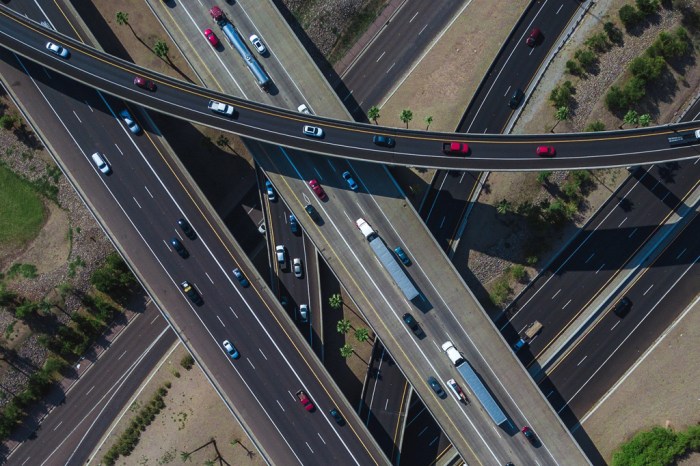Why are rear-end collisions so common on interstate highways – Rear-end collisions are a prevalent issue on interstate highways, posing significant risks to drivers and passengers alike. This comprehensive analysis delves into the multifaceted causes, contributing factors, and potential solutions surrounding this persistent problem, providing valuable insights and actionable recommendations to enhance road safety.
The following paragraphs will explore the intricate interplay of roadway design, driver behavior, vehicle technology, and enforcement strategies in understanding and mitigating rear-end collisions on interstate highways.
Causes of Rear-End Collisions on Interstate Highways

Rear-end collisions are a prevalent issue on interstate highways, often resulting in severe injuries and fatalities. Understanding the contributing factors is crucial for developing effective prevention strategies.
Speeding: Excessive speed reduces drivers’ reaction time and increases the impact force in a collision. On interstate highways, vehicles often travel at high speeds, leaving little room for error.
Distracted Driving: Distractions such as cell phone use, texting, or eating while driving divert drivers’ attention away from the road, making them less aware of potential hazards.
Following Too Closely: Tailgating, or following too closely behind another vehicle, reduces the time and space available for drivers to react to sudden stops or changes in traffic conditions.
High Traffic Volume: Heavy traffic congestion on interstate highways increases the likelihood of rear-end collisions due to frequent stops and starts, reduced visibility, and driver impatience.
Roadway Design and Visibility
Roadway design and visibility play a significant role in the frequency of rear-end collisions.
Lane Width: Narrow lanes can restrict drivers’ ability to maneuver and avoid obstacles, increasing the risk of rear-end collisions.
Sight Distance: Inadequate sight distance, caused by curves, hills, or obstructions, limits drivers’ ability to see potential hazards ahead, leading to rear-end collisions.
Lighting: Poor lighting conditions, such as during nighttime or inclement weather, reduce visibility and make it difficult for drivers to judge distances and react to changing traffic conditions.
Glare: Sun glare or headlights from oncoming vehicles can temporarily blind drivers, impairing their ability to see and respond to traffic ahead.
Inadequate Signage: Lack of clear and timely signage can confuse drivers, leading to sudden stops or lane changes that increase the risk of rear-end collisions.
Driver Behavior and Education

Driver behavior is a crucial factor in preventing rear-end collisions.
Aggressive Driving: Aggressive driving behaviors, such as tailgating, speeding, and reckless lane changes, increase the likelihood of rear-end collisions.
Fatigue: Drowsy driving impairs drivers’ reaction time, attention, and decision-making abilities, making them more susceptible to rear-end collisions.
Impaired Driving: Alcohol or drug use can severely impair drivers’ judgment, coordination, and reaction time, significantly increasing the risk of rear-end collisions.
Driver Education: Comprehensive driver education programs that emphasize safe driving practices, defensive driving techniques, and the consequences of rear-end collisions can help reduce their occurrence.
Vehicle Technology and Safety Features
Vehicle technology and safety features can play a role in preventing or mitigating the severity of rear-end collisions.
Anti-lock Braking Systems (ABS): ABS prevents wheels from locking during braking, allowing drivers to maintain control of the vehicle and reduce the risk of rear-end collisions.
Electronic Stability Control (ESC): ESC helps prevent skidding and loss of control, reducing the likelihood of rear-end collisions caused by oversteering or understeering.
Adaptive Cruise Control: Adaptive cruise control automatically adjusts a vehicle’s speed to maintain a safe following distance, reducing the risk of rear-end collisions.
Advanced Driver Assistance Systems (ADAS): ADAS features, such as lane departure warnings, blind spot monitoring, and forward collision warnings, can alert drivers to potential hazards and assist in preventing rear-end collisions.
Enforcement and Mitigation Strategies: Why Are Rear-end Collisions So Common On Interstate Highways

Law enforcement and traffic calming measures play a crucial role in deterring rear-end collisions.
Speed Limit Enforcement: Strict enforcement of speed limits can deter speeding and reduce the risk of rear-end collisions.
Distracted Driving Campaigns: Public awareness campaigns and enforcement efforts can help reduce distracted driving and its contribution to rear-end collisions.
Traffic Calming Measures: Measures such as speed bumps, roundabouts, and increased police presence can slow down traffic and reduce the likelihood of rear-end collisions.
FAQ Overview
What are the primary causes of rear-end collisions on interstate highways?
Distracted driving, speeding, and following too closely are among the leading causes of rear-end collisions on interstate highways.
How does roadway design contribute to rear-end collisions?
Poor visibility due to inadequate lighting, narrow lanes, and limited sight distance can increase the risk of rear-end collisions.
What role does driver behavior play in rear-end collisions?
Aggressive driving, fatigue, and impaired driving are significant contributing factors to rear-end collisions.
How can vehicle technology help prevent rear-end collisions?
Safety features such as anti-lock braking systems, electronic stability control, and adaptive cruise control can assist drivers in avoiding or mitigating rear-end collisions.
What enforcement strategies are effective in reducing rear-end collisions?
Speed limit enforcement, distracted driving campaigns, and increased police presence can deter rear-end collisions and improve overall traffic safety.